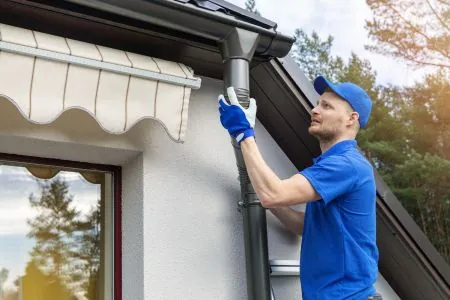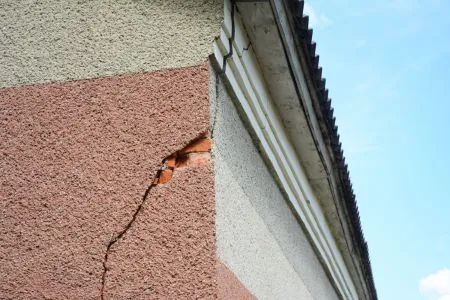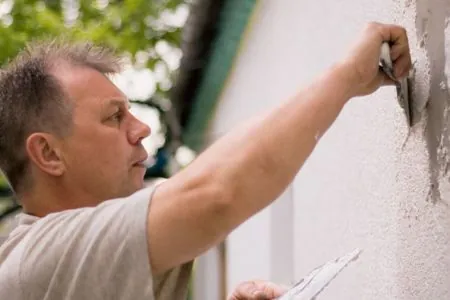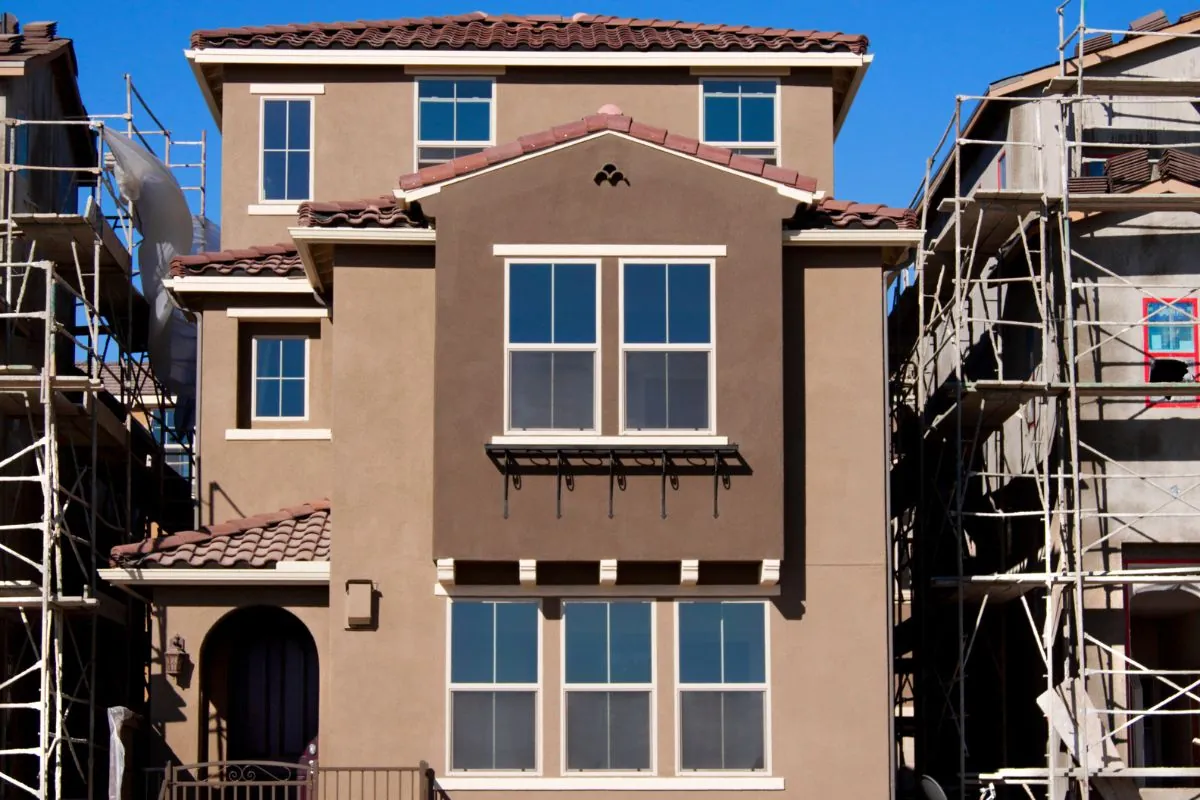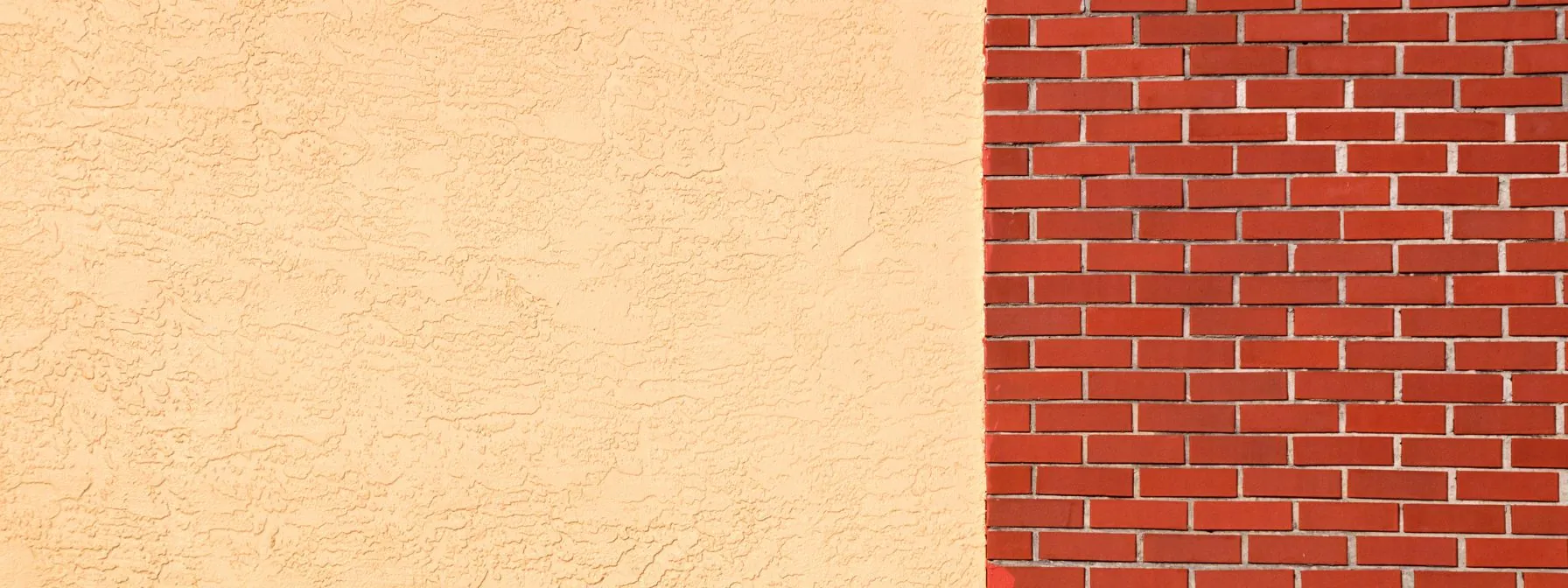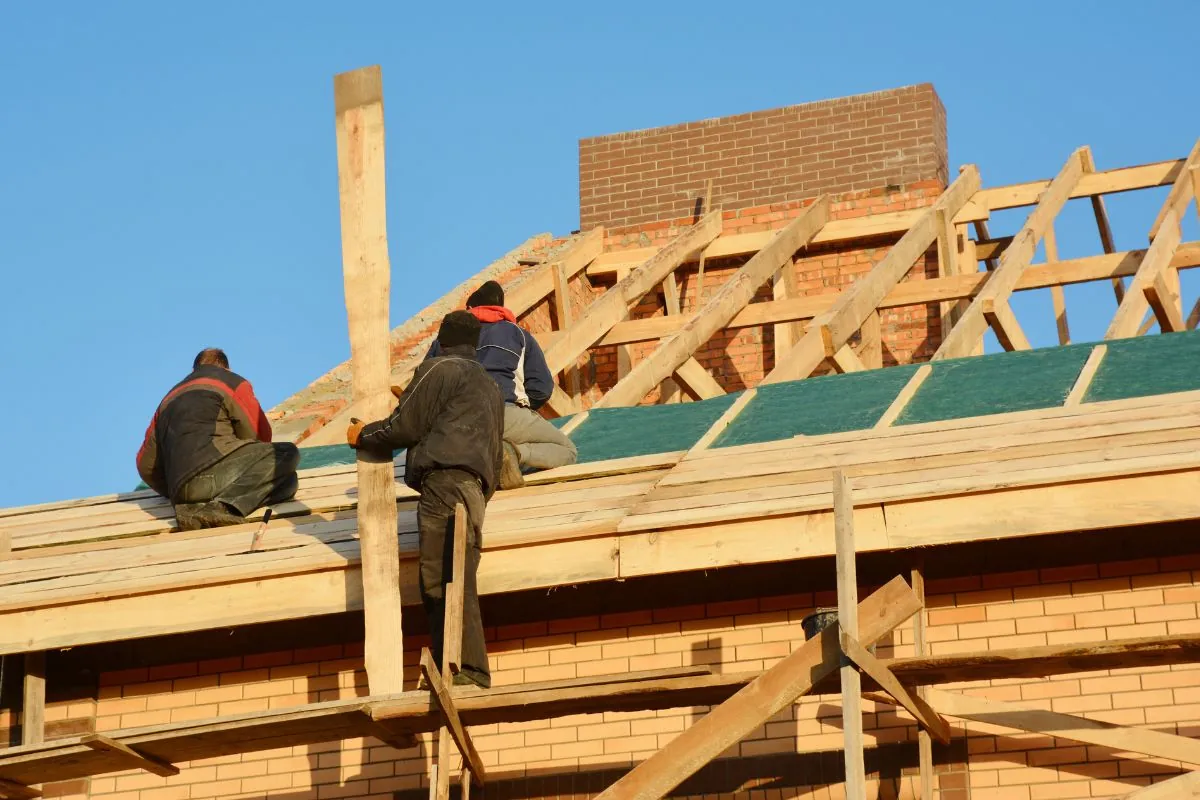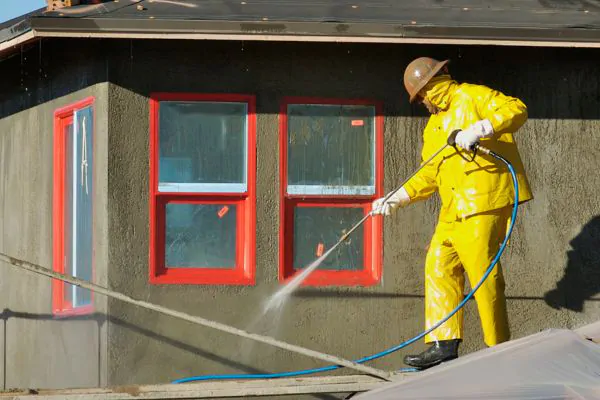
Find out how to clean stucco effectively with simple tools and techniques. Say goodbye to dirt, mold, and grime today!Stucco siding, with its classic look and durability, adorns many homes, adding a unique charm and architectural interest.
However, its textured surface can accumulate dirt, grime, and algae, detracting from its beauty and potentially harming its integrity over time.
Cleaning stucco requires a gentle approach to prevent damage to its delicate finish while ensuring it looks as pristine as ever.
Choosing the right method and tools for the job is crucial, whether you’re using a pressure washer or opting for manual cleaning techniques.
Keep reading for insight into the best practices for maintaining your stucco’s aesthetic appeal and longevity.
Why Stucco Siding Needs a Special Cleaning Approach
Stucco siding, with its unique texture and composition, calls for a nuanced cleaning method. Unlike smoother surfaces, stucco harbors dust and debris in its crevices, making it more challenging to clean without causing damage. The porous nature of stucco also means it’s susceptible to water damage if not properly handled during the cleaning process.
Cleaning stucco demands more than just a simple soap and water solution. It requires specialized cleaning agents that can penetrate the surface without harming it. Moreover, using the right tools plays a critical role in effectively removing dirt without scratching or eroding the stucco’s delicate finish.

Finally, the technique used to clean exterior stucco siding is fundamentally different from that of other materials. A gentle, yet effective, approach ensures the longevity and beauty of the stucco. Experts often recommend soft washing or low pressure washing to avoid pushing moisture into the stucco, which could lead to mold and fungus growth underneath the surface.
Preparing to Clean Stucco Siding
Before embarking on a stucco cleaning project, it’s crucial to ensure that both the stucco surface itself and its surroundings are adequately prepared.
This initial step not only sets the stage for a successful cleaning endeavor but also helps in preventing any undue damage during the process.
Two significant actions in this preparatory phase are inspecting and repairing any issues with the stucco and safeguarding the adjacent plants and surfaces from potential harm.
Tackling these tasks head-on ensures a smooth and efficient cleaning process, allowing the stucco’s pristine finish to shine through once again.
· Inspect and repair the surface
Conducting a thorough inspection for any cracks or holes before introducing any water or cleaners to your stucco siding is essential. These imperfections can not only undermine the integrity of the cleaning process but may also lead to more significant issues like water intrusion if left unaddressed. Promptly repairing these defects ensures a more effective and safe cleaning experience, preserving the stucco’s durability and aesthetic appeal.
· Protect surrounding plants and surfaces
Protecting the flora and external features near stucco surfaces before the cleaning process begins is key to ensuring no collateral damage occurs. Covering delicate plants and garden fixtures with waterproof tarps can shield them from the harsh cleaning agents and any dislodged debris. This preparatory step preserves the integrity of surrounding landscapes and prevents the inadvertent staining of patios or walkways, maintaining the property’s overall aesthetics.
How to Clean Stucco With a Pressure Washer
Cleaning stucco siding with a pressure washer represents a dynamic approach that can effectively tackle even the most stubborn dirt and grime, provided it is done with precision and care.
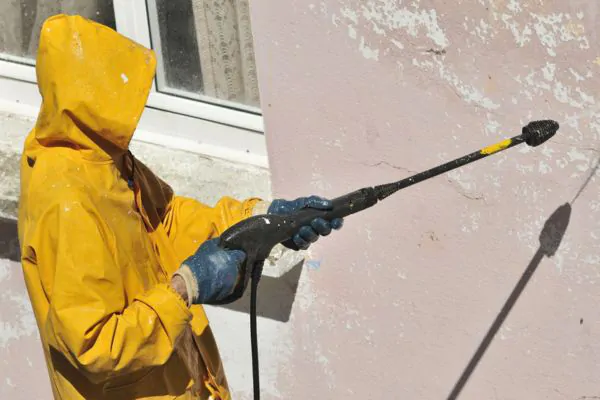
Core to this method is the fine-tuning of pressure and water flow to ensure it gently but thoroughly cleans the surface without inflicting any damage.
Selecting an appropriate cleaning solution is equally crucial, as it needs to be potent enough to break down the dirt while being gentle on the stucco itself.
The application phase comes next, requiring a meticulous spread of the solution over the stucco to ensure even coverage.
Finally, the rinsing step washes away all the loosened debris and cleaning agents, restoring the stucco’s appearance.
Each of these steps, performed sequentially, ensures the stucco not only comes out clean but also retains its integrity and aesthetic appeal.
· Adjusting pressure and water flow
Mastering the art of adjusting both the pressure and the water flow is pivotal when cleaning through stucco power washing. The key lies in finding a balance that allows water to penetrate debris without exerting force strong enough to damage the stucco’s texture. Optimal adjustments ensure a smooth, even cleaning process, safeguarding the stucco while effectively removing contaminants.
· Choosing a cleaning solution
Identifying the right cleaning solution is crucial when utilizing a pressure washer for stucco surfaces. It should be strong enough to dissolve stubborn dirt and grime, yet gentle enough to preserve the integrity of the stucco. Opting for a pH-neutral detergent is often the best choice, ensuring the cleaning process is effective without risking any damage to the stucco’s unique texture.
· Applying the solution
Applying the solution to stucco siding with a pressure washer demands precision and a methodical approach. The cleaner should be evenly distributed across the surface, using a low-pressure setting to avoid penetrating too deeply into the stucco’s porous texture. This careful application ensures the solution works effectively on the grime, setting the stage for a thorough rinse without harming the stucco’s integrity.
· Rinsing the surface
The final step in the cleaning process is a thorough rinse, which flushes away all the dirt, grime, and cleaning solution from the stucco siding. Using the pressure washer set to a gentle flow ensures the stucco’s intricate texture and integrity remain intact. This crucial phase not only reveals the true cleanliness of the stucco but also prevents any residue from drying and adhering to the surface, ensuring a vibrant and fresh appearance.
How to Clean Stucco Without a Pressure Washer
Cleaning stucco doesn’t always require heavy machinery or complex tools.
For those preferring a gentler, more hands-on approach, achieving a pristine stucco surface is still within reach using methods that rely on basic household supplies and some elbow grease.
By crafting a homemade cleaning solution tailored to the stucco’s needs, engaging in thorough scrubbing to dislodge stubborn dirt, and employing meticulous rinsing techniques with either a garden hose or a simple bucket of water, homeowners can restore their stucco to its original glory.
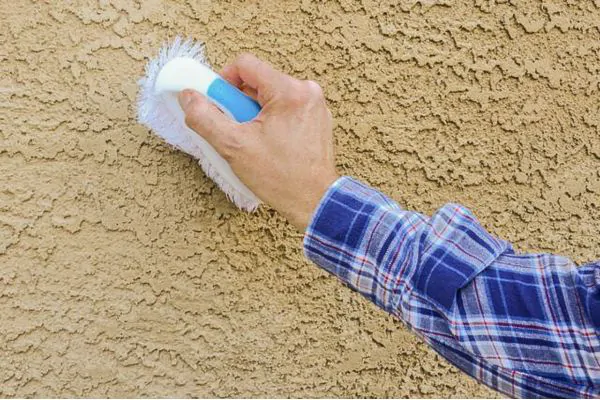
This section dives into these alternatives, providing step-by-step guidance for those seeking to maintain or revive their stucco siding without the use of a pressure washer.
· Using a homemade cleaning solution
Embarking on the task of cleaning stucco without the aid of a pressure washer opens the door to innovative, gentle methods, notably the use of a homemade cleaning solution. By combining household ingredients like water, mild soap, and a touch of vinegar, homeowners can create an effective, non-abrasive cleaner. This concoction works wonders on the stucco surface, dissolving dirt and grime without compromising the material’s integrity, leading to a beautifully maintained exterior.
· Scrubbing the surface
After applying the homemade cleaning solution, vigorous scrubbing becomes essential to effectively dislodge the embedded dirt and stains from the stucco’s textured surface. Using a soft-bristle brush, homeowners should scrub the area in a circular motion, which allows for the removal of grime without damaging the stucco. This method ensures that the surface is thoroughly cleaned, paving the way for a refreshed and vibrant exterior.
· Rinsing with a hose or bucket
Rinsing with a garden hose or a simple bucket of water serves as the final, crucial step in the stucco cleaning process, effectively washing away all residues of the cleaning solution and dislodged dirt. This method ensures that the stucco surface is left immaculate, highlighting its texture and color without the risk of water pressure damage. Homeowners should aim for a gentle yet thorough rinse, moving systematically across the surface to ensure no spots are left untreated.
Tips for Maintaining a Clean Stucco Surface

Maintaining the immaculate appearance of stucco siding isn’t just about the initial deep clean; it requires ongoing care and attention to preserve its aesthetic appeal and integrity over time.
Understanding the optimal frequency of cleaning, identifying effective solutions for common stains, and knowing when it’s time to call in a stucco professional are key components to keeping stucco surfaces pristine.
These strategies not only prolong the life of the stucco but also ensure that it continues to enhance the property’s overall look, standing out as a testament to well-executed maintenance and care.
Frequency of cleaning
Determining the optimal frequency for cleaning stucco plays a critical role in maintaining its aesthetic and structural integrity. Experts recommend scheduling a thorough cleaning at least once a year to prevent the accumulation of dirt, pollutants, and potential growths like mold or mildew. This annual routine ensures that stucco surfaces remain vibrant and damage-free, preserving the home’s appeal and value.
Solutions to common stains
Tackling common stains on stucco requires a detailed approach tailored to the specific type of blemish. For instance, mildew and mold demand a solution mixed with bleach and water, effectively eliminating fungal growth without harming the stucco’s texture. On the other hand, grease and oil stains benefit from a degreaser or a concoction of dish soap and warm water, breaking down the grease for easy removal. These targeted treatments ensure that, irrespective of the stain, the stucco retains its pristine condition and visual appeal.
Utilizing Stucco Professional
Enlisting the services of a stucco professional is sometimes the most judicious approach to ensure your stucco siding remains in top condition. These experts possess the nuanced understanding and specialized equipment crucial for identifying and remedying any underlying issues without compromising the stucco’s integrity. By choosing a skilled professional, homeowners secure peace of mind, knowing their stucco will receive the most thorough and gentle care possible.
Conclusion
Maintaining a pristine finish on stucco siding requires adopting specialized cleaning techniques that respect its unique texture and composition.
Key to this process is using gentle, yet effective, methods such as soft washing or low-pressure washing, coupled with appropriate cleaning solutions, to prevent damage and water infiltration.
Regular inspections and prompt repairs, alongside protective measures for surrounding areas, set the stage for effective cleaning.
Whether employing a pressure washer with careful adjustments or opting for manual cleaning methods with homemade solutions, mastering the balance between thoroughness and gentleness is crucial.
Additionally, maintaining the stucco’s appearance involves routine cleaning, tailored approaches for different stains, and, when necessary, the expertise of a stucco professional.
By adhering to these strategies, homeowners can ensure their stucco siding remains vibrant, enhancing the property’s overall appeal and longevity.
